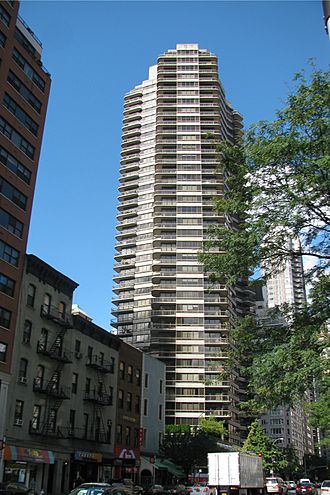Trump Plaza (New York City) facts for kids
Quick facts for kids Trump Plaza |
|
|---|---|

Trump Plaza in 2012
|
|
| General information | |
| Status | Complete |
| Type | Cooperative apartments and retail |
| Address | 167 East 61st Street, Upper East Side, Manhattan |
| Town or city | New York City |
| Country | United States |
| Coordinates | 40°45′48″N 73°57′57″W / 40.763298°N 73.965703°W |
| Named for | Donald Trump |
| Construction started | 1982 |
| Opened | March 1984 |
| Renovated | 2016 |
| Cost | $125 million |
| Height | 366 feet (111.6 m) |
| Technical details | |
| Floor count | 36 |
| Design and construction | |
| Architect | Philip Birnbaum |
| Structural engineer | Rosenwasser / Grossman Consulting Engineers, P.C. |
| Other information | |
| Number of units | 154 |
Trump Plaza is a tall building in New York City, named after Donald Trump. It's located on the Upper East Side of Manhattan. This 36-story building has both homes (called cooperative apartments) and shops. It was designed by Philip Birnbaum and cost about $125 million to build. Trump Plaza first opened its doors in 1984.
Contents
Building History: How Trump Plaza Was Built
Starting Construction in New York City
Work on Trump Plaza began in 1982. It was built where East 61st Street meets Third Avenue. Donald Trump made a deal to rent the land for 40 years. The building would pay about $1.2 million in rent each year until 2023. Trump decided to call it Trump Plaza because his other building, Trump Tower, was very popular.
The project was first expected to cost $50 million. It was planned to have 180 cooperative apartments. These homes would be located above a large retail area on the ground floor. This retail space was about 12,000 square feet.
Choosing Cooperative Apartments
Two small offices on East 61st Street were used during construction. These offices were made of brownstone. After the main building was finished, they were turned into apartments. Trump chose to build cooperative apartments instead of condominiums. He said many people wanted to live in a cooperative. He felt that cooperatives offered a sense of unity and privacy.
The apartments in Trump Plaza varied in size. They ranged from 1,200 square feet to 1,900 square feet. Prices for these homes were between $285,000 and $1 million.
Sales and Completion
Sales for the apartments started in April 1983. The first prices were around $450 per square foot. By July 1983, prices had gone up a lot. They reached up to $1,200 per square foot. At that time, half of the apartments had already been rented. The total cost to build Trump Plaza ended up being $125 million.
Opening and What Happened Next
Trump Plaza officially opened in March 1984. It had 145 homes ready for people to move in. Some famous people lived there, like former Kentucky governor John Y. Brown Jr. and his wife Phyllis George. Dick Clark and Martina Navratilova also lived in the building. When it opened, Donald Trump owned most of the building partnership.
In 2016, Trump Plaza got some updates. The old gym in the basement was changed into a playroom for kids. A new gym was built on the first and second floors. This helped the building stay modern and appealing to new residents.
Building Design: What Trump Plaza Looks Like
The Unique Shape and Materials
Philip Birnbaum designed Trump Plaza. He gave it a special Y-shape. The building is made from limestone, glass, and metal. Each floor has five apartments. The whole building has a total area of about 340,000 square feet. Even though the building has 36 stories, Donald Trump sometimes said it was 39 stories tall.
An Unusual Look for New York
Architectural expert Paul Goldberger said Trump Plaza looked very stylish. He thought it looked more like a building you might see in Caracas, Venezuela. He noted its sleek design was quite different from typical New York buildings. Goldberger also said that no one would confuse it with other tall buildings on Third Avenue. He later called it "showy" but better than the usual brick buildings in the area.
A Design Dispute
Birnbaum was later asked to design another building nearby called the Savoy. He gave the Savoy a similar look to Trump Plaza. He imagined both buildings as a grand entrance to upper Third Avenue. In April 1984, Trump sued Birnbaum and the owner of the Savoy. Trump claimed they copied his building's design and asked for $60 million. They settled the case in October 1984. The Savoy's owner agreed to change his building's design.
In 2016, Steve Cuozzo from the New York Post said Trump Plaza changed the area. He felt it brought a needed touch of class to the neighborhood. He also said it inspired four other similar towers to be built on the avenue.
Shops and Restaurants at Trump Plaza
Trump Plaza has always had shops and restaurants on its ground floor. In 1985, an Italian restaurant called Alo Alo opened there. It was owned by film producer Dino De Laurentiis.
Over the years, different stores have moved into the building.
- In 2004, Select Comfort opened a large furniture store.
- In 2007, a western-style clothing store called Billy Martin's USA opened.
- In 2012, a food shop called Lobel's Kitchen opened.
- By 2014, the Lobel's Kitchen space was available for rent. Soon after, American Apparel planned to open a store there.

